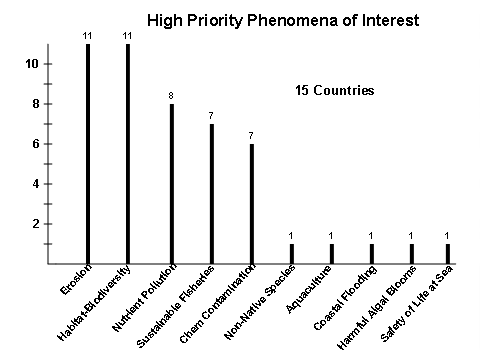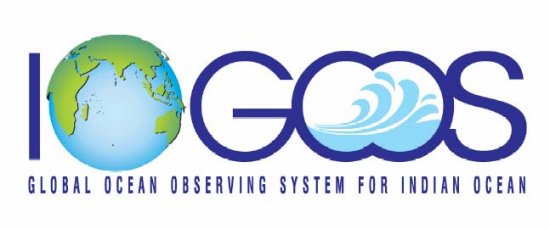ESSO - Indian National Centre for Ocean Information Services
(An Autonomous Body under the Ministry of Earth Sciences, Govt. of India)
First Conference of the Indian Ocean Global Ocean Observing System
Coastal Session Report
Thomas C. Malone,Julie Hall
-
Recommendations
-
Goals
-
Process
-
Next Steps
-
FootNotes
Recommendations
A small, but important, step has been taken toward the design and implementation of the coastal module of IOGOOS. The “Integrated Design Plan for the Coastal Module of GOOS” was used to guide the discussion of how best to initiate the implementation of the coastal module. The initial emphasis should be on the development of IOGOOS pilot projects, and an IOGOOS Coastal Development Committee (the ICDC) has been formed. The group will work to develop GOOS pilot projects under the auspices of the IOGOOS Regional Association and in collaboration with pilot projects for the ocean-climate module of IOGOOS. Active support of the IOGOOS Regional Association, the GOOS Perth Office, the IOC Programme Office in Paris, the COOP and the OOPC will be required to turn the ideas and current enthusiasm of the participants into real actions. This should include immediate follow up contact by the IOGOOS Regional Association, the Director of the GOOS Perth Office, the Head of the IOC GOOS Programme Office in Paris, the Co-Chairs of the COOP, and the Chair of the OOPC. The IOGOOS Regional Association and the GOOS Panels should identify contact persons for the purposes of coordination and collaboration. A process that will ensure the coordinated development of coastal and ocean-climate pilot projects should be established. Initially, this will involve an ad hoc groups consisting of the ICDC Executive Committee and Drs. Peter Webster and Gary Meyers.
Goals
Using the recently completed “Integrated Design Plan for the Coastal Module of GOOS” as a guide (http://ioc.unesco.org/goos/COOP-4/coop4.htm), representatives of the coastal research and coastal zone management communities from 15 countries in the Indian Ocean1 region met for the first time and agreed to the following:
Formulate three proposed pilot projects that
- target high priority phenomena of interest3 in coastal waters that are important to at least on of the six goals of GOOS and
- require regional (multi-national) to global approaches to improve the ability to more rapidly detect changes and/or to provide timely predictions of changes.
Initiate planning to establish a network of coastal laboratories for internet-based data and information exchange relevant to important environmental and ecological variability and change (sea level, river and stream flows, habitat modification, biodiversity, etc.). This will be the first step toward establishing the data communications infrastructure that will be required to build the data management infrastructure for the coastal component of IOGOOS.
Establish a Development Committee that will
- oversee the development of pilot projects, including the coastal laboratory network, and
- serve as a point of contact for the ocean-climate component of IOGOOS and other bodies interested in the development of the coastal component of IOGOOS (other regional bodies, research programmes important to the development of IOGOOS, etc.).
All three of these goals were accomplished during the two days allotted to the coastal session. Three high priority phenomena of interest to countries in the region were identified:
- coastal erosion
- loss of habitat and biodiversity, and
- sustainable fisheries.
Working groups were formed to develop an action plan for formulating design and implementation plans for IOGOOS pilot projects intended to demonstrate that the GOOS approach will provide the means for more rapid detection of changes in these important phenomena of interest. Specific goals were established for each project and the scope of each project was agreed to. The next step will be to coordinate with the ocean-climate module of IOGOOS in the formulation of proposals.
Process
The break-out session on Tuesday began with one presentation per country in which high priority phenomena of interest were identified (Figure 1). Then, based on societal impact, feasibility and the likelihood of funding, a consensus was achieved on the three top priority phenomena of interest: coastal erosion, loss of habitat and biodiversity, and sustainable fisheries.
Working groups were formed to begin discussions that will lead to the following:
- specification of objectives, potential products, and likely user groups for each project
- formulate a time-line and a process for developing the proposal
- identify potential funding sources and
- develop a plan for establishing a laboratory network for data and information exchange that will facilitate the achievement of the goals of the pilot projects
Next Steps
The IOGOOS Coastal Development Committee3 was formed to provide a mechanism for collaboration and coordination with existing GOOS-related efforts in the region in general and with the ocean-climate module of IOGOOS in particular; to oversee the drafting of proposals for pilot projects in collaboration with related ocean-climate projects; and to initiate the establishment of a coastal laboratory network for data and information exchange and the development of community-based activities in support of the coastal pilot projects.
The development of each of the pilot projects will be led as follows:
- Coastal erosion – Santarin Mooloo, Nalin Wikramanayake
- Habitat/biodiversity – Greg Wagner, Mohideen Wafar
- Fisheries – Tickie Forbes, Nicolette Demetriades.
An informal liaison committee has been established to coordinate the development of the ocean-climate and coastal pilot projects. In addition to the IOCDC, this group consists of Peter Webster, Gary Meyers, Neville Smith, and Ed Harrison4.

Figure 1. Based on a poll of 15 coastal states in the Indian Ocean region, coastal erosion and changes in habitat and biodiversity were identified as top priorities. After discussion, the group reached consensus on the third top priority, sustainable fisheries. These will be the subject of pilot projects that are intended to contribute to the establishment of the coastal component of IOGOOS.
FootNotes
1. The goal is to provide opportunity to all coastal nations in the Indian Ocean Region to participate in and benefit from IOGOOS. For the 1st IOGOOS Conference, the scientists and coastal zone managers from the following coastal nations participated: Australia, Bangladesh, Comoros, India, Iran, Kenya, Madagascar, Malaysia, Mauritius, Mozambique, Qatar, Réunion, Rodrigues, Seychelles, Sri Lanka, and South Africa.
2. Pilot projects must meet the following criteria: (a) targets phenomena of interest that are important to achieving one or more of the 6 goals; (b) completion of the project is likely to lead to more rapid detection and/or timely prediction of phenomena of interest that are high priorities for the region; (c) requires multi-nation collaboration and exchange of data (d) has a high probability of obtaining international funding
3. Phenomena of interest are changes occurring in coastal waters that impact on marine operations, public health and well-being, ecosystem health, and/or the sustainability of living marine resources (e.g., changes in sea state, current fields, coastal flooding and erosion, increases in the concentration of enteric bacteria, habitat modification, loss of biodiversity, coastal eutrophication, harmful algal blooms, invasions of non-native species, chemical contamination, declines in marine fisheries, and aquaculture production).




